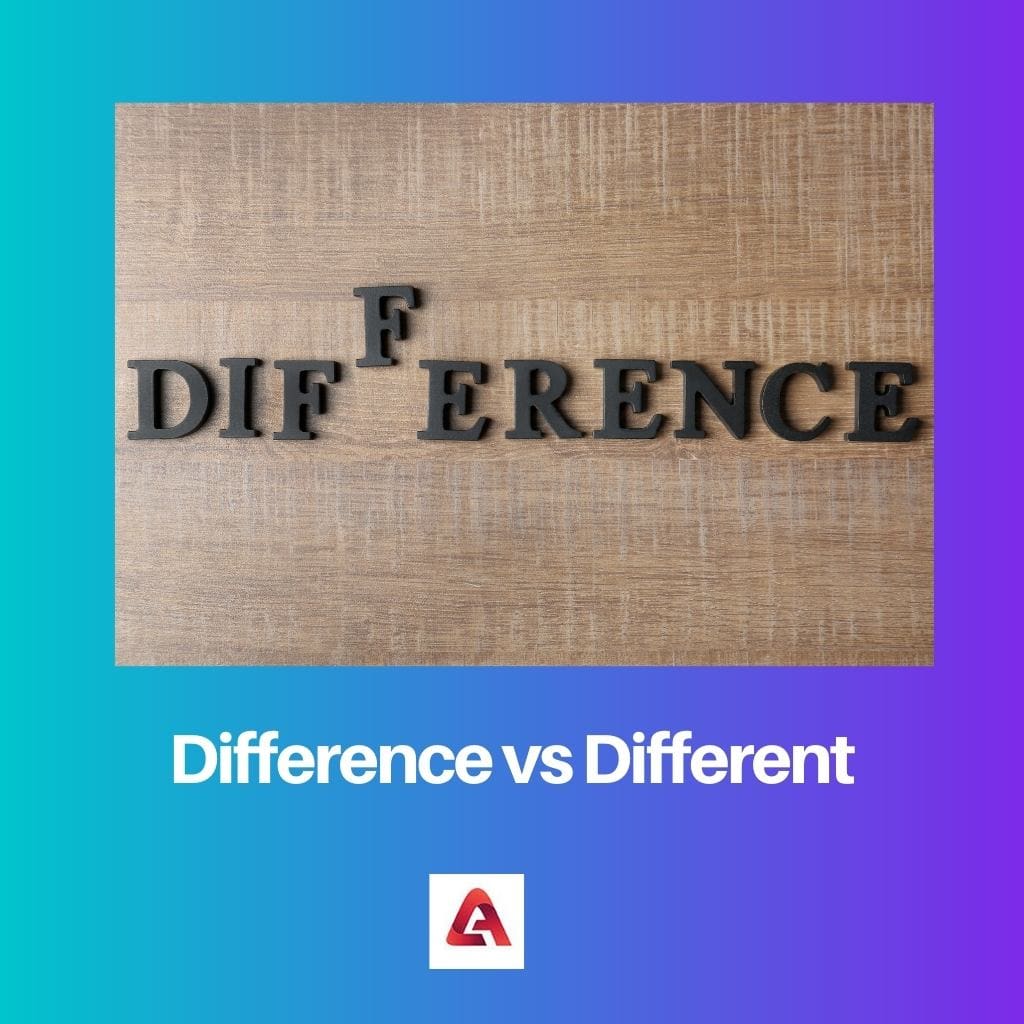The English language can be vague; it has infinite precepts and several exceptions. Therefore, the terms are organized. And it takes ages and time to analyze and acquire their use peculiarly and utterly.
Even then, people confuse and misplace them. Often they are mistakenly used interchangeably, but that doesn’t fit right in the vocabulary.
Such as, the words Difference and Different are distinct but are used interchangeably. It might sound like a tongue twister, but the two words compared in the sentence have quite divergent uses.
The two are used in a sentence when it is required to clarify the contrasting qualities by comparing two or more concepts or ideologies.
Key Takeaways
- Difference refers to the contrast or variation between two or more things, while Different refers to the state of being unlike or distinct.
- The difference is a noun used to describe the result of comparing two or more things, while Different is an adjective used to describe a quality or characteristic of a single thing.
- The difference is used in comparative contexts, while Different is used in descriptive contexts.
Difference vs Different
The difference is the degree of dissimilarity or variation between two or more things. It is used to compare and contrast things and highlight their distinctions. Different refers to something that is not the same as something else; difference compares while Different describes.

Comparison Table
| Parameters of Comparison | Difference | Different |
|---|---|---|
| Defining both the Terms | The difference is a noun is placed before or after the comparative terms. | The word Different is used as an adjective that is placed in between the two comparative terms. |
| Source of Emergence | It emerged from the verb Differ. | It also emerged from the verb Differ. |
| Function in the Sentence | It is the relation or state of being distinct. | It is the quality or characteristic of being distinct. |
| Latin Derivation | Its Latin derivation is ‘Differentia,’ which means Diversity in English. | Its Latin derivation is ‘Differentem,’ also shortly, ‘Differe.’ It means Dissimilarity in English. |
| Part of Speech | It is a Noun of Differ. | It is an Adjective of Differ. |
| Noun | The word Difference is itself a noun. | The word Different needs a noun in a sentence to form. |
| Usage | It describes the areas of variance of two different subjects or objects. | It is used to describe the distinctive aspect of the subject or object. |
| Suffixes | Its suffix is ‘-ence.’ | Its suffix is ‘-ent.’ |
| Formation of the Sentences | “Subject/ Object and + Subject/ Object have + Difference” Or“Difference between Subject/ Object and + Subject/ Object.” | “Subject is + Different from + Subject/ Object.” |
| Example with Sentence | I can see a clear difference in his behaviour from usual. | His behaviour is different than usual. |
| Positioning in the Sentence | It is placed in the sentence before the starting of the two comparative sentences/ terms/ words or after their ending. | It is placed in between the two comparative sentences/ words/ terms. |
What is Difference?
The difference is a noun is placed before or after the comparative terms. Its suffix is ‘-ence.’ It helps illustrate the variations between the two subjects or objects.
The term has its evolution from the verb Differ. The Latin derivation is from the word Differentia, which means Diversity in English. Its part of speech is a noun, meaning it is used as a name in the sentence.
Be it any two comparative sentences/ terms/ words, according to the formation, it is positioned in the sentence before the starting or after the ending of it.
The sentences are formed such as ‘Subject/ Object and + Subject/ Object have + Difference’ or ‘Difference between Subject/ Object and + Subject/ Object.’
Examples:
- I can see a clear difference in his current behaviour from usual. (Here, the Difference is used before in the sentence, the current behaviour is subject1, and the usual is subject2).
- Tea and Coffee have a difference. (Tea is an object1, Coffee is an object2, and the Difference is used after them).
- Difference between Boomers and Zoomers. (Similarly, here, Difference is used before the terms).

What is Different?
The word Different is used as an adjective that is placed in between the two comparative terms. It is another emerged word from the verb Differ.
It is derived from the Latin term Differentem, which is shortly Differe, which means Dissimilarity in English.
Different is an adjective used in a sentence to convey the quality. It describes the uniqueness that appears to be in the two concepts. It ends with its suffix ‘-ent.’
‘Subject is + Different from + Subject/ Object’ is the formation of the sentence. The adjective is placed between the two comparative sentences/ words/ terms.
Examples:
- His behaviour is different than usual. (Here, a Different is used between both the terms).
- This dress is different from the others. (Similarly, here, a Different is used between both the objects).
- Government is different from Politics. (Again, a Different is used between both concepts).

Main Differences Between Difference and Different
- The word Difference is used as a noun in a sentence. Whereas the Different is an adjective.
- Both words are the emergence of the verb Differ. But the former is derived from the Latin word Differencia and the latter from Differe (also Differentem).
- The first one functions as the relation or state of being distinct. On the other hand, the second one is the quality or characteristic of being definite.
- The Difference helps to specify the areas of variance between two different subjects or objects. On the contrary, the Different helps with describing the distinctive of the subject or object.
- The suffix of the first word is ‘-ence.’ Conversely, the second has ‘-ent.’
- With difference, the sentences are formed like ‘Subject/ Object and + Subject/ Object have + Difference’ or ‘Difference between Subject/ Object and + Subject/ Object.’ But with different, they are formed like ‘Subject is + Different from + Subject/ Object.’
- The previous is positioned at the beginning or the ending of the two comparative terminologies, while the succeeding is between the two comparative ideologies.

- https://link.springer.com/chapter/10.1007/978-94-017-6059-1_9
- https://books.google.com/books?hl=en&lr=&id=ZMQDAAAAQAAJ&oi=fnd&pg=PA9&dq=difference+and+different+grammar&ots=17XMR63PvK&sig=sp8EfYQXJYLn7sG7fLLutO7pq7E
This article has been written by: Supriya Kandekar



